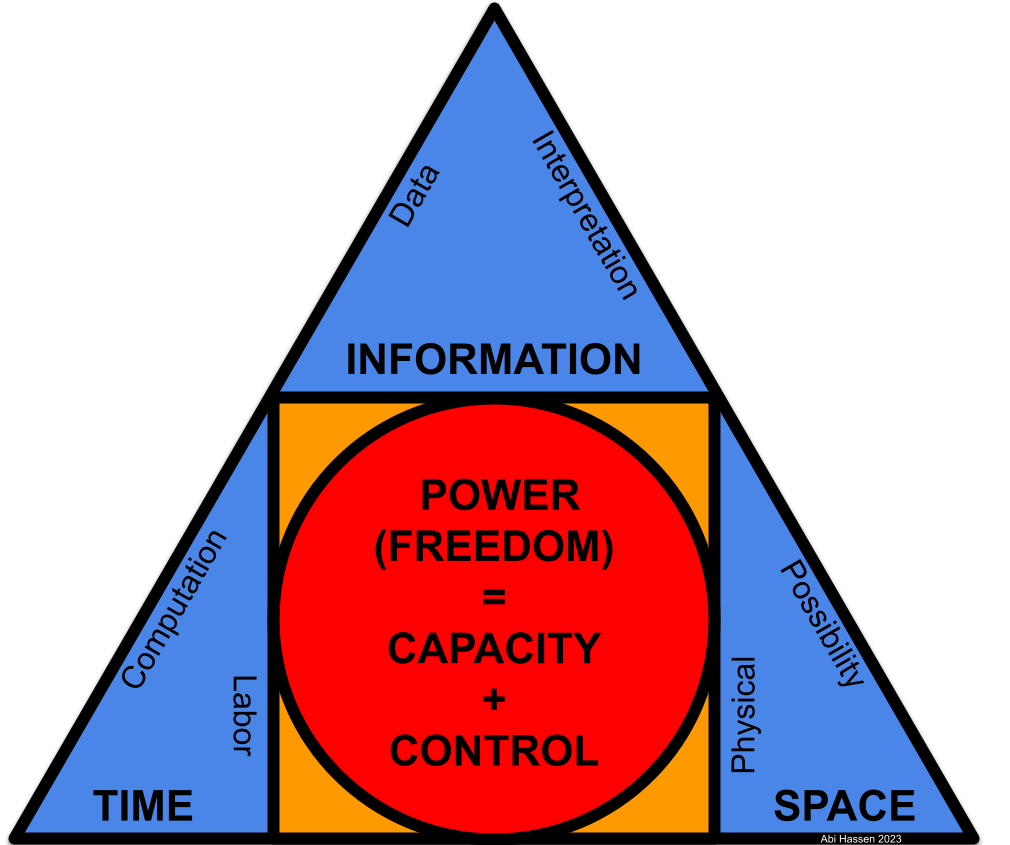
This chart is meant to function as a tool for developing a power analysis to understand relative strength within a world of material forces. This is not directed toward creating an all-encompassing analysis of every kind of power, rather, it is a rough way to help orient around power within a complex world.
At the center are the concepts of Power, Control, and Capacity. Freedom is in brackets beside Power because, for present purposes, Power is a necessary condition (or capacity) for Freedom. How we measure our Power is by evaluating our access to and our ability to control each of the three main components: TIME, SPACE, and INFORMATION. The three main components are the major dimensions of our physical world and are therefore the starting point for any accounting.
TIME is the constantly expiring resource that defines our existence. We only have so much in our life and it always seems as if we either have too much or too little. Time, when it’s “free” is many people’s concept of freedom, but it is also the means of meeting our retribution in our mass incarcerating society (freedom is relative to context). When we attempt to quantify our access to time we should consider our free time, but also our capacities in the subcategories of Time, Labor and Computation. These two concepts are very similar in that they represent a physical transformative process over time, but Labor is cheated toward the side of SPACE and Computation toward INFORMATION for a reason.
- Labor is the process of manipulating the physical world (SPACE). Labor takes place within a context that makes particular outcomes more or less useful and valuable. For example, growing food might have a low “market” value under conditions of abundance or to someone with plenty, while having infinite value during a time of famine or to a person who is starving. Labor differs from Computation in that the primary context for evaluating Computation is primarily the realm INFORMATION (see below).
- Computation is the manipulation of INFORMATION. Calculating climate models, routing Uber drivers, and sequencing DNA are all computational processes. Computation works on the raw material of Data (below).
SPACE what we move through and the structures and infrastructures we build. Different kinds of spaces are governed by their own laws of motion and are littered with different kinds of objects forming distinct terrains and modes of movement across those terrains. The distinction of SPACE between Physical Space and Possibility Space is meant to help us understand how we might be able to move through any particular terrain. Think about a prison. Movement in the prison is controlled by a conjunction of physical barriers as well as rules and categorizations (see Interpretation below) that limit the Possibility Space available to any particular person.
- Physical SPACE is the buildings we erect, our homes, workplaces, and public areas. SPACE is also the streets we drive and march in and parks we picnic in or occupy. Land ownership, trespass laws, policing, and surveillance all regulate our capacity to control SPACE.
- Possibility SPACE represents the plane of potential action. Ideology, belief, morality are structures that form the terrain of possibility space.
INFORMATION is probably the trickiest concept to understand, but it is the realm where a lot of today’s political struggle takes place. INFORMATION is the opposite of randomness, it is what distinguishes order from chaos. For practical purposes, information is how we store and retrieve meaning. If we think of a book or a computer program, they both are made of a series of physical units (letters and binary digits) that need to be read using a particular interpretive scheme (language or computer operating system). This split is roughly the split between Data and Interpretation that form the two concepts below:
- Data is the raw material of information. Anything that can be interpreted as meaningful can be understood as data. This means letters and numbers, but also molecules (like DNA). But data is meaningless unless it can be interpreted. And how data is interpreted is an unending, complex, and fraught arena of struggle.
- Interpretation comes last, but is easily the most powerful, difficult, and controversial concept here. Interpretation is the context that gives any particular order meaning, including our understanding of all of the other concepts. But, this is not meant to be an extended discourse on interpretation. We should think interpretation pragmatically as our capacity to create and promulgate interpretations. How do we understand our current needs and concerns? How capable are we of refining, reevaluating existing interpretations and creating new ones? What is our ability to get others to adopt our interpretations?